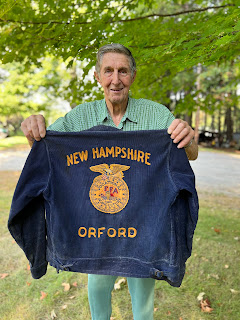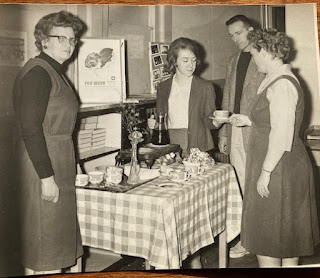Gladys Barr Boyd graduated from Mary Hitchcock Hospital nurses program in 1944 and then entered the Army Nurses Corps. Working for Lyme's Dr. William Putnam, she cared for patients in Fairlee, Thetford and Lyme area.
Betty Rainey Minot graduated from St. Johnsbury's Brightlook Hospital nursing program in 1949. After working for four years at the old Woodsville Cottage Hospital, she was Dr. Harry Rowe's first employee in what became the Wells River Clinic.Journal Opinion Nov 27, 2024
This column is the first of two exploring the role of local women in medicine in times past. It includes the careers and contributions of two 18th-century midwives and two 20th-century registered nurses. The second column will cover the careers of three local physicians.
These seven women all
practiced locally. Examining the lives of these individuals is not meant to
exclude others, but rather to use them as a way of focusing on the contribution
of women to the health care of local residents.
Before the 19th-century, the family-centered care for the
ill was traditional. The birthing process, was one with only female relatives,
neighbors, and midwives attending. Historian Laurel Thatcher Ulrich wrote,
“Rural midwives were capable of managing difficult as well as routine births…”
Although little is known about their training, it is assumed that they acquired
knowledge by practice and observation of more experienced midwives.
Midwife Lydia Peters was born in Connecticut around 1741. In
1766, she and her husband Benjamin Baldwin moved from Connecticut to Orford.
Ten years later, they moved to Bradford to join other members of their
families. Baldwin was, to use Ulrich’s description of another midwife, “a
gifted woman, a skilled practitioner, careful about her fees and sure of her
methods.”
Bradford historian Silas McKeen wrote, “(She) was a woman
highly distinguished for her cheerfulness, resolution, and energy. Besides bringing up a large family of her
own, and managing her domestic affairs in an exemplary manner, she for many
years was extensively, and with remarkable success in the practice of
midwifery.”
Her practice included Bradford, Corinth, Fairlee, Piermont,
and Orford. When called, regardless of the weather or time, she went. She rode sidesaddle on her own mount or on a
pillion behind the man who had come for her. She kept a careful diary of her
work.
She charged a few shillings for her services and was often
paid in goods or services rather than hard money. In over 50 years of practice,
she delivered 926 children including 10 pairs of twins. Of her number, 16 babies were stillborn and 7
were illegitimate. Only one mother died
of complications while Baldwin was in charge.
She performed her last delivery at age 78. She died on September 3,
1825, at the age of 85.
Bathsheba Rich was another midwife who made her mark in the
area. Born in 1752 in Connecticut, she
moved with her parents to Strafford VT around 1773. She married Richard
Wallace in 1776 and moved to Thetford. During the Revolution, she maintained
the family farm while her husband was away with the militia. In the years following the Revolution,
Wallace became skilled as a midwife in Thetford and six other area towns.
Thetford historian Martha Howard points out: “She was an
accomplished horsewoman, and her sorrel mare with Bathsheba astride must have
been a welcome sight to laboring women in need of her care. Day and night, good weather or bad, Bathsheba
responded to requests for assistance.
She and her horse are even credited with crossing the swollen
Ompompanoosuc River on a bridge stringer to reach a woman in distress on the
other side.”
In the 42 years that Wallace practiced, she delivered 1,666
babies, including 21 sets of twins. No
mother ever died in her care. Records show that she was in personal control of
her earnings, an unusual practice at the time.
She acquired the title Granny Wallace, “a common term of
respect and affection that was given to women who worked as midwives.” She died
in 1832.
Wallace and Baldwin’s record of success was difficult for
male physicians to replicate as the practice of midwifery was replaced by the
male-dominated medical profession’s control of deliveries.
Nursing eventually expanded beyond maternity care. The Civil War solidified the need for
professional trained nurses. After so
many attendants cared for the wounded on the battlefield and in hospitals.
Not long after the Civil War, in 1873, nursing training
schools opened in Boston, New York and New Haven. By 1900, there were hundreds
of nursing schools across the nation, including in New Hampshire and Vermont.
The first training school for nurses in New Hampshire opened
at the State Hospital in Concord in 1888.
In 1893, Hiram Hitchcock established the Mary Hitchcock Memorial
Hospital School of Nursing in Hanover. That school began with a two-year
program, increased to three years in 1905. The program closed in 1980. In 1953, Saint Anselm College in Manchester
established the first four-year nursing program.
Woodsville’s Cottage Hospital began a two-year nursing
program as early as 1903, the first classes drawing students from Canada. In 1933, the program was expanded to three
years, but the final class graduated in 1936.
In Vermont, the Brightlook Hospital nurses training program
opened in St. Johnsbury in 1900. The Thompson School of Practical Nurses in
Brattleboro and the Barre City Hospital School of Nursing opened in 1907. In
1911, Vermont enacted the first licensure law regulating nursing practice in
the state.
UVM created a
bachelor’s degree in nursing in 1943 to meet the increased demand for nurses.
Other programs opened at Norwich University in 1958 and Vermont College in
1961.
Despite the increase
in the number of men in the nursing field, about 88% are still women. The
following are two local women who were exemplary members of the nursing
profession.
Gladys Lucy Barr was born in 1922 in Topsham. After
graduating from Woodsville High School in 1940, she entered nurses’ training at
Mary Hitchcock Memorial Hospital in Hanover, NH.
After graduating from the three-year program 1944, Boyd
joined the Army Nurse Corps in 1945 and served in Italy, being discharged in
February 1947. Shortly after her discharge, she went to work in the Lyme office
of Dr. William Putnam.
In 1949 she met and
married Merton Boyd, and for the next 18 years, they made their home in
Fairlee. When the approaching new interstate highway threatened their
neighborhood, the family of five moved to Thetford.
Working with Putnam often meant Gladys Boyd assisted with
frequent in-home births. Sometimes, when the doctor was not immediately
available, she did the procedure herself.
Such was the case in 1957 when she arrived at the Martin
farm on the Fairlee-Bradford border to find that the doctor was not readily
available. She proceeded to deliver my
sister-in law, Kathy Martin Oakes.
In addition to traveling with the doctor to visit patients,
Boyd was a major force in the Lyme office. Dr. Putnam was my wife’s primary
care physician during her childhood and after our marriage in 1968, we
continued to visit the office.
I recall Boyd’s approach to situations as one of being very
much in charge. She was gentle but firm and efficient. Undoubtedly our
experience with her is a primary reason I selected Boyd for this column.
Boyd’s son Peter shared with me some memories of his mother.
He said that while she performed all the regular nursing duties in the Lyme
office, she “often worked outside the system by providing advice, care and even
medicine to those in need.” He recalled that late-night visits from or to
neighbors who were ailing, were fairly routine.
“No such thing as a fee for those services then, it was just
what she did,” he said, “Her sense of commitment to others extended to her own
family, where she undertook senior and hospice end-of-life for her parents and
other members in her own home.”
Boyd also used her nursing skills in service to the wider
community. From 1951 until the 1980s she was an attending nurse at blood
drives. She donated blood as well. She organized dental and eye testing clinics
and conducted vaccination clinics for measles and polio in area communities on
both sides of the river. After retirement, she often served as the school nurse
for the Orford, Fairlee and Thetford schools.
As early as 1951, she organized local fund-raising drives
for the American Red Cross, and in the 1980s. she was chair of the American
Heart Association Vermont fund drive. In the early 1960s, she helped start the
Valley School in North Thetford for area special needs students.
She was a participating member of the Silver Leaf Grange,
the Fairlee PTA, the Fairlee Federated Church, and Church Women United. After
the family moved to Thetford, she joined corresponding groups in that town.
There, Boyd was active in the First Congregational Church of
Thetford, volunteered for the town library, was a classroom assistant at the
elementary school, and participated in the senior citizen mentoring program.
She helped start the Norwich-Thetford Visiting Nurse Association. She delivered Meals on Wheels, and cooked
meals for the senior citizens’ weekly luncheons.
“Gladys also cared for her community with the same sense of
commitment that she cared for her patients,” said longtime Thetford resident
Dana Grossman, who recruited Boyd to run for the Thetford School Board in the
1980s. “When I asked her whether she’d be willing to run for the board, her
willingness to serve the town’s schoolchildren, even though that was a somewhat
challenging time in town politically, came without hesitation.”
“Her approach to life
made her a wonderful role model for her patients, but also for all the other
people lucky enough to know her.” Gladys Boyd died on December 31, 2005, at her
home in East Thetford.
Beatrice “Betty” Rainey was born in 1929 in Lyndonville.
After graduating from Lyndon Institute, she entered nursing training at St.
Johnsbury’s Brightlook Hospital Nursing School.
In 1950, she married
Alden Minot and went to live on the Minot Farm in West Bath. The following
years meant being involved as the farmer’s partner, helping with chores,
maintaining a large garden and raising her family.
Minot worked for four years as a registered nurse at the old
Cottage Hospital in Woodsville. In 1954, she became Dr. Harry Rowe’s first
employee in what became the Wells River Clinic and continued there until her
retirement in 2002.
I recently spoke with Brenda Minot of Bath. She was Betty
Minot’s daughter-in law-and medical associate at Rowe’s clinic. She recalled
that “patients loved Betty,” because she was “professional, friendly, and
experienced.” They had “confidence in
her.” She said that as years went by, the doctors, especially younger doctors,
came to rely on her for her opinion. She added that patients often called Betty
at home for advice.
At the time of her passing in 2018, those who knew her
contributions to the Clinic recalled that “things clicked at the Clinic,”
thanks to her. They spoke of her as a
“marvelous capable woman” whose kind and gentle manner eased the fears that
patients might have.
In addition to her nursing, Minot was “a force in the
community.” She was active in the Bath Congregational Church and was
superintendent of the Sunday School for over 40 years. She was a leader in the
Bath Historical Society and Friends of Bath.
More broadly, she and Alden founded the Cottage Hospital
Volunteer Ambulance Service and taught First Aid and CPR courses. They spent
some nights and holidays at the hospital, covering the ambulance service.
She was a Grafton County Farm Bureau member and 4-H Dairy
Project Leader. In the mid-1960s, Minot was on the Planning Board for a
possible regional school district.
Gladys Boyd and Betty Minot are just two of the women who
have fulfilled the roles of nurses’ assistant, licensed practical nurse,
registered nurse, and, more recently, nurse practitioner. They are proof of the
dedication those medical professionals show to both their patients and their
communities.





















